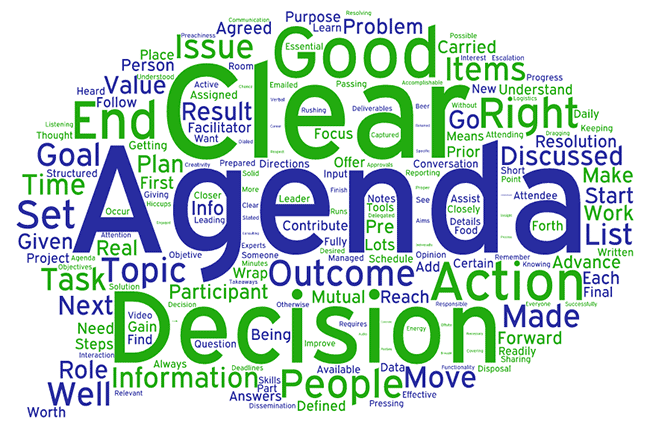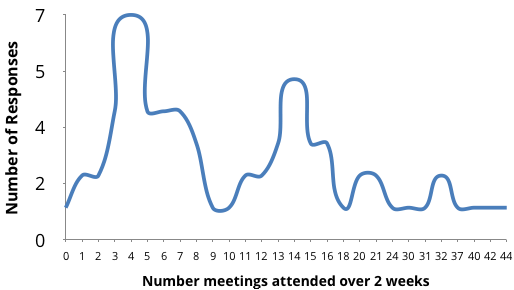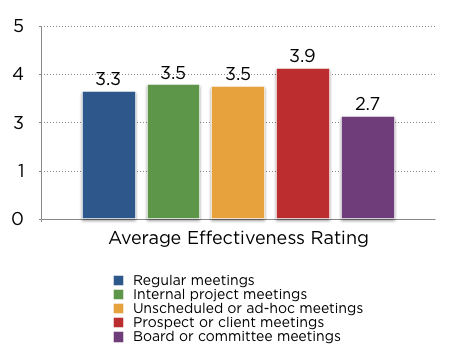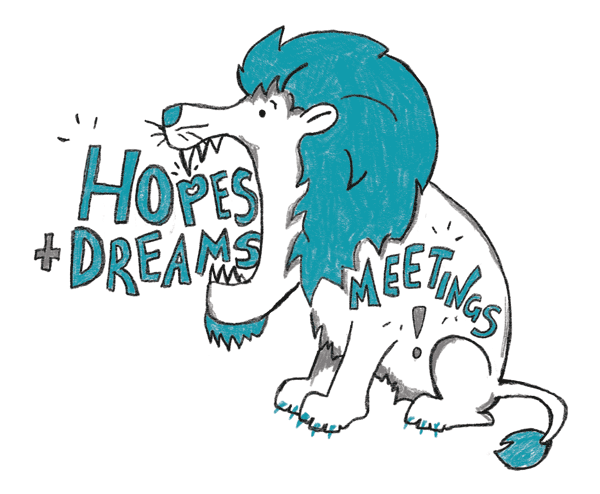Survey Results: What Makes Meetings Worth Attending
In December, we published A Fresh Look at the Number, Effectiveness, and Cost of Meetings in the U.S., which dug into what the available research could tell us about those things. What we found suggested that people meet more than ever, and for the most part, they find those meetings pretty effective.
Still, questions remained. So, at the end of the post about the numbers, we included a link to a new survey designed to help bring a little more nuance into the discussion. It’s a short survey, and we haven’t exactly been overwhelmed with responses. 67 so far. Still, the responses we do have are starting – just barely – to put some more shape to the picture.
If you haven’t had a chance to fill it out yet, never fear! There’s still time! The survey remains open and we plan to share more in the future.
Here’s a peek at what we know so far.
What makes meetings effective?
The question we ask specifically is:
In your opinion, what makes a meeting worth attending and a good use of your time?
The survey format allows for very short answers, so people focused in on what matters most to them. While answers vary considerably, there are some notable themes.

Here are a handful of verbatim responses.
A meeting is worth attending when…
There’s no other choice
“When no other means can offer the info available.”
Preparation Makes Perfect
Adequate preparation, in the form of clear goals and an agenda, is the most common theme so far.
“Well prepared, by all the participants.”
“Clear agenda with topics that are relevant to my work and which I have value to contribute to the conversation or should be part of the decision-making process.”
“That people understand what the meeting is about, what their role is and there is someone keeping people on topic.“
“We go in with a clear lists of problems in advance – and always end up moving forward on the issue / question / problem we had in the first place. I can’t remember a time when things didn’t progress to final resolution (disposal)…”
Results Matter
Several others are all about the bottom line.
“If a decision is made with clear outcomes and deliverables.”
“Concrete outcomes.”
“Something results from the meeting – some action!”
“Clear results, specific action items for follow up, plan for meeting next.”
“If we look at data and make a decision, with solid next steps that are accomplishable by the other person.”
“Meeting takeaways, follow-up action items agreed to, assigned, and actually OCCUR.”
Learning something new
Several people care mostly about the new information they’ll learn during meetings.
“Lots of information given and retained.”
“Learn something from it, gain insight to improve your daily career functionality.”
“Consulting with experts to find answers.”
“It has to have new information or some value add, and it should be offsite when possible.”
People! Participation and Personalities
We’ve said it before – bad meetings are made of people! Of course — and so are the good ones.
For some, the interpersonal skills mattered most.
“Communication skills of each participant.”
“All participants have active role, want to see desired outcome.”
“Clear purpose, mutually understood, and of mutual interest. Clear agenda. Energy, attention, focus and creativity brought to the agenda. No rushing, no dragging. Start and finish on time, without preachiness about it.”
Others want a chance to fully participate.
“My opinion is not left out.”
“Giving everyone a chance to be heard and listening to what they say.”
And a few want a bit less participation.
“Written schedule, certain people not attending.”
“My skills are required, I’m not just there to be informed (I can read the minutes of meeting for that)”
And finally, my personal favorite and a key to a meeting that’s definitely worth my time:
“Good beer, good B.S.“
All of the above
Most answers included a single phrase or sentence. But really, it’s all of it, isn’t it?
“Good meetings (a) have an agreed purpose and agenda, (b) have the right attendees and no more, (c) focus on decisions and information dissemination that requires verbal interaction (e.g. can’t readily be emailed).
As an attendee, I am looking for (a) information I don’t have, (b) commitments I can’t readily get or make otherwise, and (c) discussions and decisions that move me closer to my goals (WIIFM).”
About the Numbers
The bulk of the survey asks some basic demographic questions, how many and what kind of meetings people attend, and which kind of meetings are considered most effective.
While we don’t yet have a statistically significant number of replies, the early patterns are interesting.
How many meetings?
Rather than guess, we asked people to literally open their calendars and count how many meetings they attended over a two week period.
In total, 65 respondents attended 821 meetings in two weeks, including meetings for work and outside of work. At the high end, people said they attended an average of 4 meetings per day. At the low, some reported no meetings at all (or perhaps they just decided not to answer that bit). Using simple math, the group as a whole averages just over 1 meeting per day.
No surprises there. Our sample size is still really small, but this already falls within the range reported by the earlier studies we reviewed before.
What we didn’t expect was how diverse the responses are. They’re all over the map! And while the average matches the averages from earlier studies, most people reported attending far fewer meetings than we expected, especially since 69% claimed to work at some level of management.
Is this a more accurate description, with really no meaningful standard number of meetings? Were these people just looking at unusually slow weeks? Clearly, the verdict is still out.

What kind of meetings?
Next, we asked which kind of meetings people attended. Every meeting has context. Was the meeting for work, or for something outside the day job? Internal, with clients, with competitors? This wasn’t information we were able to find in the studies we’d reviewed.
94% attended meetings for work.
57% also attended meetings outside of work.
There was quite a bit of debate here at Lucid HQ about how to further refine the categories of meetings – so many options! – but in the end we settled on these:
- Regular department, team, one-on-one or group meetings
- Internal project, program, or development meetings
- Prospect or client meetings
- Board or committee meetings
- Unscheduled or ad-hoc meetings
No respondents attended every type of meeting; everyone only had some of these meetings on their calendar.

How many people at each meeting?
When we work on designing meeting templates here, we’ll often reference books and resources created by master facilitators. Professional facilitators excel at what we call “Meetings”, or meetings with a capital M – managing critical discussions with large groups of people. Then, we work to adapt these “M”eeting techniques for online meetings and smaller groups, as most working meetings involve fewer attendees than the sessions the professionals facilitate.
Which begs the question – what is the most common group size for a meeting?
According to the replies thus far, the answer is 4.
Again, this varies by the type of meeting. On the small side, ad-hoc meetings had an average of 3.5 attendees. Board and committee meetings, on the other hand, average 11.2 attendees – helping justify some of the special rules governing these more complex conversations.

How effective are those meetings?
Last but not least, we asked people to rate the effectiveness of each type of meeting they attended on a scale of 0 to 5.
- 0 – Not at all effective; waste of time
- 1 – Not effective
- 2 – Somewhat ineffective
- 3 – Somewhat effective
- 4 – Effective
- 5 – Very effective; Key to success
The most common answer? (both the median and mode for all responses)
4 – Effective
The average rating for all meetings?
3 – Somewhat effective
Clearly, some bad meetings are dragging the average down. This chart show the average rating of effectiveness by type of meeting.

This inspires lots of new questions. Researchers have found that meeting effectiveness tends to dive once you have 8 or more participants. But — are these larger meetings rated less effective because they have more people in them, or because of the kind of meeting? Board and committee meetings can be challenging regardless of the group size.
Or perhaps big meetings rate as less effective because we don’t hold them often enough to get really good at it? Some of my favorite meeting experiences were in very large “M”eetings led by professional facilitators, who buck this trend.
Or is this just the average-skewing-impact of a small number of unhappy folks, which you’re more likely to find the more people you survey?
Cause, effect, correlation – reveal yourselves!
Again, the survey is still open if you and everyone you’ve ever met would like to help uncover the truth.
Still – lonely meetings are the worst
At the beginning of the post I mentioned we had 67 legitimate replies, but when counting the number of meetings attended, we only included meetings from 65 respondents.
The other two people said the average number of attendees in their meetings was either 1 or 0, and as a result, those meetings rated a 0 for effectiveness. Total waste of time.
And so I leave you with this closing thought.
We know not all the meetings go well, and not all the time we spend together is as fulfilling as it could be. By sharing what our meetings really look like and what each of us feels works for us personally, hopefully we can move together from an average of somewhat effective to mostly effective, and even regularly on to great.
Yet despite their many faults, meetings often beat the alternatives. As our pair of lonely meeting attendees reinforced, Eric Carmen had it right.
When I was young
I never needed anyone
Making love was just for fun
Those days are goneAll by myself
Don’t wanna be all by myself anymore!Eric Carmen – All by Myself, 1975
Still here? If you haven’t already, take the survey. Comments, questions, and suggestions encouraged below.



